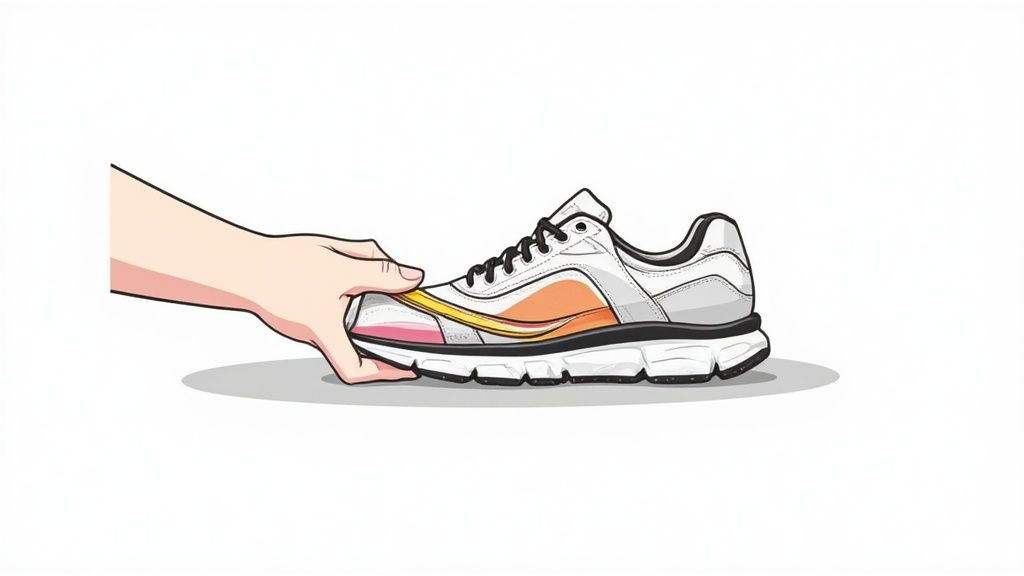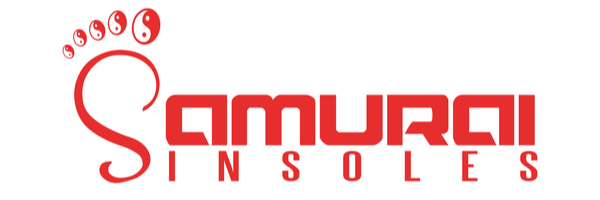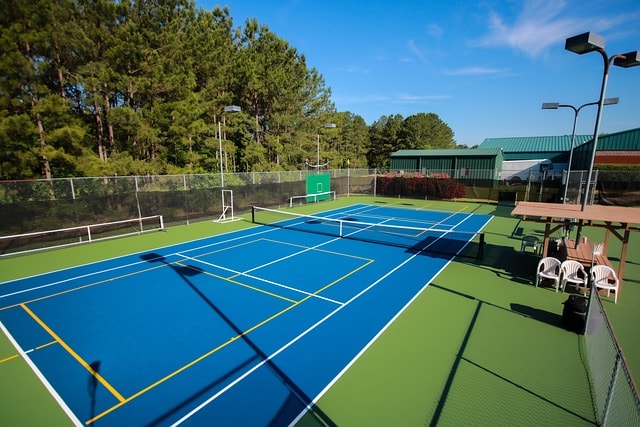Think of your foot's arch as the natural suspension system for your entire body. When it’s doing its job, it effortlessly absorbs shock and keeps you balanced with every step. But when that arch is misaligned or isn't getting the support it needs, that shock has to go somewhere—usually straight up into your knees, hips, and back, often leading to persistent pain.
This is where arch support orthotic insoles step in. They aren't just simple cushions. They are biomechanical tools designed to realign your foot and restore its natural function.
How Do Arch Support Orthotic Insoles Actually Work?

To really get it, picture a car with bad wheel alignment. You know the signs: the tires wear down unevenly, the ride feels bumpy, and the whole vehicle is under stress it wasn't built to handle. Your feet work on a very similar principle.
If your arch isn't properly supported, it can lead to common biomechanical problems like overpronation, which is just a technical term for your ankle rolling too far inward as you walk. An arch support insole acts like a skilled mechanic for your feet. It doesn't just add a layer of padding; it actively guides your foot back into its most efficient and natural position.
By providing a firm, supportive structure right under the arch, it prevents it from collapsing and helps you maintain a healthy, neutral alignment from the ground up.
Correcting the Pain Chain Reaction
A misaligned foot sets off a chain reaction of stress that travels right up your body. Think of it as a series of dominoes. An unstable foot can cause your knee to twist slightly, which in turn can make your hip drop, forcing your lower back to compensate for the imbalance. Before you know it, you've got pain in places that seem completely unrelated to your feet.
An arch support orthotic provides stability right at the source, effectively stopping that chain reaction. Here’s a quick breakdown of how they do it:
- Pressure Redistribution: The insole helps spread the impact of each step evenly across your entire foot, instead of letting it all slam into your heel or the ball of your foot.
- Plantar Fascia Relief: For anyone dealing with the sharp, stabbing pain of plantar fasciitis, a good insole lifts the arch to reduce the constant stretching and strain on that critical ligament.
- Neutral Alignment: A well-designed insole uses a deep heel cup and a structured arch to work together, keeping your ankle from rolling too far inward or outward and encouraging a more natural stride.
To put it simply, here’s a look at the core functions of these insoles.
Core Functions of Arch Support Insoles
| Function | How It Helps Your Feet | Common Conditions Addressed |
|---|---|---|
| Stabilization | Controls foot motion and prevents the arch from collapsing. | Overpronation, Flat Feet |
| Pressure Redistribution | Spreads impact forces evenly across the foot. | Metatarsalgia, Heel Pain |
| Shock Absorption | Reduces the jarring impact of walking and running on hard surfaces. | General Foot Fatigue, Joint Pain |
| Alignment Correction | Guides the foot, ankle, and leg into a neutral position. | Plantar Fasciitis, Knee Pain, Back Pain |
By addressing these core mechanics, the right insoles can provide significant relief and prevent future issues from developing.
More Than Just a Soft Cushion
It's a huge misconception that more cushioning automatically means more comfort. While a soft, squishy insert might feel nice for a minute, it often does nothing to address the real source of foot pain: poor alignment. It’s like trying to fix a crooked wall by leaning a pillow against it. It might feel better temporarily, but it doesn't solve the underlying structural problem.
This is why truly effective orthotic insoles use semi-rigid materials. They need to be firm enough to provide corrective support but still have enough flex to allow your foot to move naturally. This balance is the secret to getting both immediate relief and promoting better long-term foot health.
These biomechanical principles are exactly how do orthotic inserts make a difference in your daily life. They treat the cause, not just the symptom. Whether you spend all day on your feet for work or just enjoy a casual walk, the right insole can transform each step from a source of strain into a moment of supported, pain-free motion.
Why Modern Foot Care is More Important Than Ever

If you're dealing with nagging foot pain, take comfort in knowing you are definitely not alone. Your search for a solution is part of a much bigger story—one shaped by demanding jobs, active lifestyles, and a growing understanding of just how vital our feet are to our overall health.
Think about what we ask of our feet every day. We stand for hours on unforgiving surfaces, pound the pavement during our workouts, and simply navigate the natural changes that come with age. Our feet take a beating, and this constant stress has turned what used to be an occasional ache into a widespread problem.
This isn't just a few isolated cases of sore feet; it's a global health trend. The need for effective, easy-to-use foot care has never been greater, and that demand is fueling some incredible innovation in products like arch support orthotic insoles.
The Link Between Chronic Health and Your Feet
The push for better foot support isn't just about tired feet. It's also driven by major demographic shifts and a rise in chronic health conditions that have a direct impact on the lower body. Many people don't realize that problems starting elsewhere often show up as serious issues in their feet, making proper support a key part of managing their overall health.
Diabetes and arthritis are two of the biggest culprits. Both conditions can lead to foot deformities, nerve damage, chronic pain, and make it difficult to get around.
The numbers are truly staggering. The Institute for Health Metrics and Evaluation (IHME) projects that by 2050, diabetes could affect up to 1.3 billion people worldwide. In that same period, cases of osteoarthritis are expected to climb past 1 billion. On top of that, musculoskeletal disorders—another major contributor to foot pain—already impact an estimated 1.71 billion people.
These statistics make it crystal clear. For billions of people, looking after their feet isn't just about comfort; it's essential for staying mobile and maintaining their quality of life. This massive need has pushed the orthotics industry to innovate, finally moving us away from old-fashioned, clunky designs.
A Whole-Body Approach to Wellness
This focus on foot care is part of a larger shift in how we think about our health. We're more aware than ever of how interconnected our bodies are. Your feet are the foundation for everything above them, and when they're out of alignment, the ripple effect can travel all the way up to your neck.
As people become more proactive about their well-being, even things like maintaining good posture in the office have become a priority. This highlights the bigger picture: proper foot alignment is a cornerstone of good posture, proving just how foundational good support really is.
This new awareness has completely changed what people expect from foot care products. We're no longer willing to settle for one-size-fits-all inserts or choose between support and comfort. We’re now looking for solutions that are:
- Based on Real Science: Products built on proven biomechanical principles that get to the root cause of the pain.
- Easy to Get and Use: High-quality options that don’t require a costly and time-consuming specialist appointment.
- Made for Real Life: Slim, versatile insoles that actually fit into the shoes we wear every day without feeling bulky.
Today’s advanced arch support orthotic insoles are the answer to this call. They aren’t just accessories; they are sophisticated tools engineered to solve a very real, and growing, problem. When you choose a modern orthotic, you’re getting the benefit of years of research and development driven by the needs of millions. So rest assured, you’re not just buying an insole—you’re investing in a solution that works.
Could Orthotic Insoles Be Your Solution?

Does this sound familiar? You swing your legs out of bed, and a sharp, stabbing pain shoots through your heel. Or maybe it’s a dull, throbbing ache in your arches that sets in after a long day on your feet. It could even be that nagging knee or back pain that flares up after a simple walk. If you've been nodding along, the root of the problem might be right under your nose—or rather, under your feet.
Many people find incredible relief with arch support orthotic insoles, but they're not a magic bullet for everyone. The real question is whether your specific pain or daily routine makes you a good candidate for the kind of support they provide. Let's look at some real-world situations where the right insole can make all the difference.
Relief for Specific Foot Conditions
For some, foot pain isn't just about being tired; it’s a chronic, diagnosed condition. When your foot's mechanics are off, stress gets focused on all the wrong places. This is exactly where targeted arch support becomes a hero.
-
Plantar Fasciitis Sufferers: This is probably the number one reason people start looking for insoles. That thick band of tissue under your foot, the plantar fascia, gets inflamed and angry. An arch support insole gently lifts the arch, taking the strain off that ligament. This not only helps it heal but can provide immediate relief from that awful first-step-in-the-morning pain.
-
People with Flat Feet (Overpronation): If you have flat feet, your arch likely collapses with every step. This causes your ankle to roll too far inward—a motion called overpronation—and that can throw your entire body's alignment out of whack. A good, structured insole gives your foot the arch it's missing, helping to stabilize your foundation from the ground up.
-
Those with High Arches (Supination): On the other end of the spectrum, very high arches are often rigid and don't absorb shock very well. This puts a ton of pressure on the ball of your foot and your heel. An arch support insole helps spread that pressure out more evenly across your whole foot, improving shock absorption and preventing pain in those high-pressure spots.
Everyday Heroes Standing Tall
You don't need a medical diagnosis to get huge benefits from better foot support. Millions of us work jobs that keep us on our feet for hours, usually on hard, unforgiving floors. For these folks, arch support orthotic insoles are more about preventing a problem than fixing one.
Just think about the daily grind for people in these roles:
- Nurses and healthcare workers hustling down long hospital corridors.
- Teachers pacing in front of a classroom all day.
- Retail and service staff standing at a counter or walking the sales floor for an entire shift.
- Construction and warehouse workers on concrete floors, often carrying heavy loads.
For these individuals, tired feet aren't just an inconvenience. They're a professional hazard that can lead to chronic pain and burnout. By providing consistent support throughout the day, insoles fight off that cumulative strain, keeping feet and legs feeling much fresher for much longer.
Boosting Athletic Performance and Safety
Athletes push their bodies to the limit, and their feet are where the rubber meets the road—literally. Every jump, sprint, and pivot sends shockwaves up the body. Here, proper foot alignment isn't just about comfort; it's about performance and staying off the injured list.
A good arch support insole helps optimize an athlete's mechanics. By making sure the foot is properly aligned, it creates more efficient power transfer, improves stability when changing direction, and cuts down on wasted energy. Even more importantly, it helps fend off common overuse injuries like shin splints, Achilles tendonitis, and runner's knee, which can often be traced right back to poor foot mechanics.
So, whether you're fighting a specific foot condition, enduring long hours at work, or pushing your physical limits, the right support can be a total game-changer. It’s all about building a stable foundation so you can move through life with more comfort and confidence.
How to Choose Your Perfect Arch Support Insoles

Walking into the world of arch support orthotic insoles can feel a bit overwhelming at first. There are so many options, and they all seem to promise instant relief. So, how do you find the pair that’s actually right for you?
The good news is that you don’t need to be a podiatrist to make a smart choice. Once you understand a few key things about your own feet and what you need, you can pick an insole with confidence.
It's no surprise the market is booming. More people are learning about foot health, and the global foot orthotic insoles market, valued at around USD 4.83 billion in 2024, is expected to hit USD 8.23 billion by 2033. That's because countless people are finding real relief from common problems like plantar fasciitis and flat feet.
This guide will walk you through the process, step by step, so you can feel good about where you're putting your money—and your feet.
H3: Start with Your Arch Type
If there’s one thing to get right, it’s this: your arch type. It's the absolute most important factor. Why? Because your arch dictates how your foot handles weight and absorbs the shock of every step. An insole designed for a flat foot won't just be useless for a high arch; it could actually be uncomfortable.
Thankfully, you can figure out your arch type with a simple "wet test" right at home.
- Pour a little water into a shallow pan.
- Wet the bottom of one foot.
- Step firmly onto a piece of cardboard or a thick paper bag.
- Step off and take a look at the footprint you left behind.
That simple shape tells a big story. A full, solid footprint means you likely have low arches or flat feet. If you only see your heel and the ball of your foot with a skinny line connecting them, you have high arches. Anything in between, with a clear curve on the inside, points to neutral arches.
H3: Match the Material to Your Needs
The material an insole is made of determines what it does best. It's not about finding the "best" material overall, but the best material for your specific goals. Are you just looking for some soft, squishy comfort, or do you need serious, structured control?
An effective orthotic isn't just a cushion. It must strike a balance between firm, corrective support and flexible comfort. A soft gel insert might feel nice for a minute, but it often fails to fix the underlying biomechanical issues that are causing the pain in the first place.
To make this easier, let's break down the common materials and what they're good for.
Insole Material Comparison
| Material Type | Primary Benefit | Best For | Example Use Case |
|---|---|---|---|
| Soft Gel or Foam | Cushioning & Shock Absorption | Mild fatigue, standing comfort | A retail worker who wants extra padding but doesn't have major alignment issues. |
| Semi-Rigid Composite | Structured Support & Control | Correcting overpronation, plantar fasciitis, flat feet | A runner with flat feet who needs to control foot motion and stabilize their stride. |
| Firm Plastic or Carbon Fiber | Maximum Rigidity & Control | Severe overpronation, significant instability | Often found in prescription orthotics for serious biomechanical correction. |
For most people trying to solve common foot pain, a semi-rigid composite really is the sweet spot. It's firm enough to guide your foot into proper alignment but still flexible enough to be comfortable all day long.
H3: Consider Your Activity Level
What you do all day matters, too. An insole that feels fantastic in your dress shoes might not hold up during your morning run.
- Low-Impact Activities (Walking, Standing): Look for an insole that provides steady support and some cushioning to keep foot fatigue at bay.
- High-Impact Activities (Running, Sports): You'll want an insole with excellent shock absorption and durable, firm support to handle that repetitive pounding and help prevent injuries.
Ultimately, finding the right insole is about putting these pieces together: your arch type, the right material, and your activity level. If you'd like to explore this further, our guide on how to choose the right insoles has even more helpful advice. By being thoughtful about your choice, you can confidently pick the arch support orthotic insoles that will give you a better foundation, from the ground up.
A Smarter Solution for Everyday Comfort is Finally Here
The world of arch support orthotic insoles has exploded, but all that choice has created a huge problem. You're usually stuck with two bad options. You can either get the bulky, super-rigid orthotics a podiatrist might recommend (good luck fitting those into your favorite shoes), or you can grab a flimsy gel cushion that feels good for about five minutes and does absolutely nothing to help your actual foot problem.
It’s a frustrating trade-off. We knew there had to be a better way.
So, we set out to create an insole with the biomechanical smarts of a medical orthotic, but with a sleek, lightweight design that actually fits into your life. That’s the entire idea behind Samurai Insoles. We wanted to end that compromise for good. Our goal was to build an orthotic that truly addresses the root causes of foot pain, yet is so slim and discreet it just disappears into the shoes you already love to wear.
Where Technology Meets Real Life
This isn't just about shaving down some foam to make an insole thinner. It's about a complete rethinking of how an insole should work, using advanced materials and a targeted design to give you powerful support without all the clunky baggage. Instead of just padding your foot, Samurai Insoles are designed to be a biomechanical tool.
The real magic is in our springy, polypropylene inner core. This molded inner shell is the engine of the insole. It’s engineered to gently guide your foot, keeping your arch from collapsing and putting a stop to overpronation before it can cause pain. It’s firm where it needs to be to realign your foot’s structure, but it’s also flexible enough to move with you. The result is dynamic support that feels natural, not like you have a brick in your shoe.
What really makes this design work so well is how focused it is. By concentrating the support into a lab-tested inner shell right under the arch, the insole delivers serious correction exactly where it counts. This allows the rest of the insole to stay thin, light, and comfortable.
This targeted approach solves the #1 complaint about traditional orthotics: they are just too bulky and awkward for everyday life. With a design that slips effortlessly into everything from sneakers and work boots to dress shoes, getting consistent, effective support is no longer a chore.
What's Next for Foot Care?
People are more aware of their foot health than ever before, and they’re demanding better solutions. They want products that are backed by science but are also convenient enough to use without completely changing their lifestyle. This shift is driving huge innovations in the foot orthotic market.
You just have to look at the numbers. The orthopedic insole market was valued at USD 3.2 billion in 2025 and is expected to more than double to USD 6.7 billion by 2035. This massive growth is happening because of new technology and a wider appreciation for how much foot health matters. For example, some leading brands are now releasing materials that boost shock absorption by as much as 25% in lab tests. You can dive deeper into these trends in this detailed orthopedic insole market analysis.
Samurai Insoles fit perfectly into this new wave of foot care. By delivering a product that is both biomechanically effective and incredibly easy to use, we represent the next evolution in helping people feel better on their feet. We’re here to prove that you don’t have to choose between real relief and the shoes you want to wear.
Your Questions About Orthotic Insoles Answered
So, you're considering arch support orthotic insoles. You get the general idea, but what's it actually like to use them day-to-day? Let's walk through some of the most common questions people have when they're starting out.
How Long Does It Take to Get Used to New Insoles?
There’s almost always a short adjustment period. Think of it like getting a new pair of glasses—your brain needs a moment to adapt to a new, clearer way of seeing. It's the same for your feet and posture.
We suggest wearing new orthotics for just 1-2 hours the first day. After that, you can gradually add another hour of wear each day. For most people, it takes about one to two weeks to feel completely natural. You should feel a firm, supportive pressure under your arch, but never any sharp pain. This slow and steady approach lets your body realign comfortably without feeling forced.
The goal is for the insole to feel like a natural extension of your foot. If you experience significant discomfort beyond a gentle "awareness" of the support, it's a sign to ease back on the wear time.
Can I Move My Insoles Between Different Shoes?
Absolutely! That’s one of the best things about a great pair of over-the-counter arch support orthotic insoles. They’re designed to be swapped easily between your sneakers, work shoes, or casual boots.
Just pull them out of one pair and slip them into another. The key is making sure they sit flat and snug without sliding or bunching up. While you might need a different, slimmer style for very specific footwear like tight dress shoes, one good pair will work for the vast majority of your shoe collection. This means you get consistent support all day long, no matter what's on your feet.
When Should I Replace My Orthotic Insoles?
How long your insoles last really depends on the materials and how much you wear them. A good rule of thumb is to give them a quick visual check-up every six months or so. Look for tell-tale signs of wear and tear, like:
- Visible cracks in the firm, supportive part of the insole
- Areas that look obviously flattened or compressed
- The top fabric cover starting to peel away or looking threadbare
But the biggest clue is how your body feels. If that old foot, knee, or back pain starts to make an unwelcome return, it’s a pretty clear sign the insoles have lost their supportive structure. For daily users, planning to replace them every 12 months is a solid guideline to make sure you're always getting the support you need.
Ready to find a smarter solution designed for all-day comfort and real relief? Samurai Insoles offers a range of targeted orthotics that fit perfectly into your life and the shoes you already love.
Explore our collection and start your 60-day risk-free trial today!



